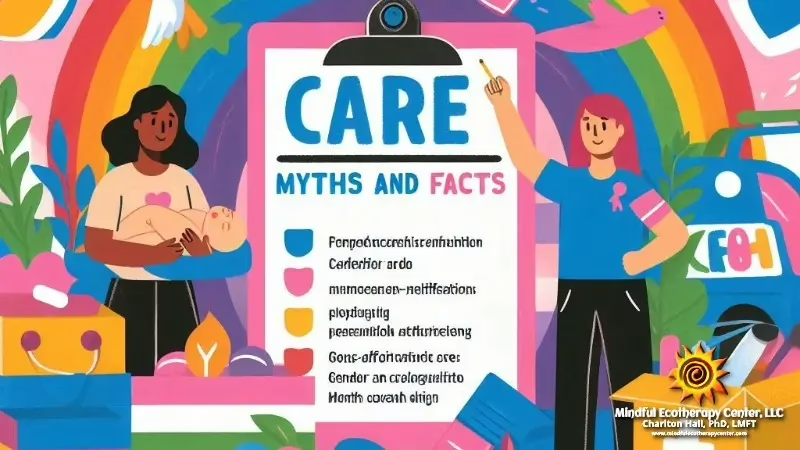
Table of Contents
Myths about gender-affirming care persist due to a lot of misinformation. Gender-affirming care is an essential component of healthcare for transgender, nonbinary, and gender-diverse individuals. However, despite its positive impact on well-being, this type of care is often misunderstood or surrounded by misconceptions. In this post, we’ll explore some common myths about gender-affirming care and provide factual, evidence-based responses to debunk them.
Myth 1: Gender-Affirming Care is Only for Adults
Fact: Gender-affirming care is tailored to the individual’s age and stage of development. For young people, this care often focuses on social affirmation, such as using chosen names and pronouns, or reversible interventions like puberty blockers. Contrary to myths, surgery is almost never performed on children under the age of majority.
The data on gender-affirming surgeries for minors under the age of 16 in the United States is limited, but available research suggests that such procedures are extremely rare. For example, a study published in 2023 found that among individuals aged 12 to 18, only a small percentage underwent gender-affirming surgeries, with most procedures being chest surgeries rather than genital surgeries. Additionally, from 2019 to 2023, approximately 5,747 minors received gender-affirming surgeries, though this figure includes individuals up to the age of 18.
In all cases, when the child is under the age of legal consent, parents are guardians have given consent. It is a myth that gender-affirming surgery can be performed on a person under the age of legal majority without parental permission.
Gender-affirming care for people under the age of legal majority is generally reversible and designed to give individuals time to explore their gender identity safely, without making permanent changes. Medical procedures like hormone therapy and surgeries are typically reserved for adults or older adolescents, with careful consideration and consent.
Myth 2: Gender-Affirming Care Forces People to Transition
Fact: Gender-affirming care is not about pushing anyone toward transition. Instead, it’s about supporting individuals in aligning their lives with their authentic selves. For some, this may involve medical interventions, while for others, it might only involve social changes or mental health support. The goal is to empower individuals to make informed decisions about their care, based on their unique needs and desires.
Myth 3: Gender-Affirming Care is Experimental
Fact: Gender-affirming care is supported by decades of clinical research and evidence. Major medical organizations, including the American Medical Association (AMA) and the World Professional Association for Transgender Health (WPATH), recognize it as safe, effective, and essential for improving mental health outcomes. Studies consistently show that gender-affirming care reduces depression, anxiety, and suicidal ideation among transgender and gender-diverse individuals.
Myth 4: Gender-Affirming Care is Always Irreversible
Fact: This is a nuanced topic. Some aspects of gender-affirming care, like puberty blockers, are entirely reversible—when treatment is paused, puberty resumes naturally. Hormone therapy may have some reversible effects, depending on the duration of use. However, certain surgical interventions are permanent and undertaken only after thorough evaluation and consent. No underage child can receive surgery without the consent of a parent or guardian. Also contrary to popular myth, gender-affirming surgery is never something done on impulse or a whim. The process is always guided by informed decisions from the individual and their healthcare team.
Myth 5: Gender-Affirming Care is a Quick and Easy Process
Fact: Gender-affirming care is a thoughtful, individualized process that takes time. In spite of what the myths out there might want you to believe, it involves consultations with medical professionals, mental health assessments, and discussions about goals and expectations. Each step is taken with care to ensure the individual’s safety and well-being. The myth that it’s a quick or impulsive decision ignores the depth of the process and the care taken in providing it.
Myth 6: Gender-Affirming Care Harms Children
Fact: Gender-affirming care is shown to significantly benefit children and adolescents. It provides a supportive framework for young people to explore and express their gender identity. Research demonstrates that access to gender-affirming care reduces risks of mental health issues, including depression and suicide, in transgender youth. The care is always age-appropriate and designed to prioritize the child’s best interests.
Myth 7: All Transgender People Pursue Medical Transition
Fact: Not all transgender or nonbinary individuals seek medical interventions. Gender-affirming care is highly personalized, and people’s needs vary widely. Some individuals may opt for hormone therapy or surgeries, while others may choose social changes like name or pronoun usage. The spectrum of gender-affirming care reflects the diversity of experiences within transgender and gender-diverse communities.
Myth 8: Gender-Affirming Care is Not Supported by Science
Fact: Gender-affirming care is grounded in substantial scientific evidence. Peer-reviewed studies and clinical research consistently highlight its benefits for mental health and overall well-being. Leading medical institutions worldwide endorse gender-affirming care as a critical aspect of healthcare for transgender individuals.
Conclusion: Fostering Understanding Through Education
Dispelling myths about gender-affirming care is essential for creating a more inclusive and supportive society. By relying on factual information, we can better advocate for the rights and well-being of transgender, nonbinary, and gender-diverse individuals. Understanding the truth behind gender-affirming care helps foster empathy, acceptance, and equitable access to essential healthcare.
Share Your Thoughts!
Please feel free to share your thoughts in the comments below!
Don’t forget to check out our YouTube channel for more information and content!
Schedule a Teletherapy Appointment with Charlton Hall, MMFT, PhD, LMFT
For those seeking personalized guidance in incorporating Mindfulness-Based Ecotherapy into their lives, Charlton Hall, MMFT, PhD, LMFT, offers professional teletherapy sessions. With extensive expertise in MBE, Dr. Hall provides tailored strategies to help individuals overcome insomnia and achieve restorative sleep.
How to Schedule an Appointment:
- Visit the Mindful Ecotherapy Center Website to find more information about Dr. Hall’s approach to sleep wellness and mindfulness-based therapies.
- Book a Consultation – Easily schedule a teletherapy session that fits your availability.
- Receive Expert Guidance – Work one-on-one with Dr. Hall to develop a personalized sleep-improvement plan using MBE techniques.
By integrating Mindfulness-Based Ecotherapy into your daily routine, you can naturally enhance your sleep quality, reduce stress, and achieve long-term wellness.
Schedule an Appointment Today!
Ready to take the next step? Schedule a session with Charlton Hall today and start your journey to better sleep through the healing power of nature.

